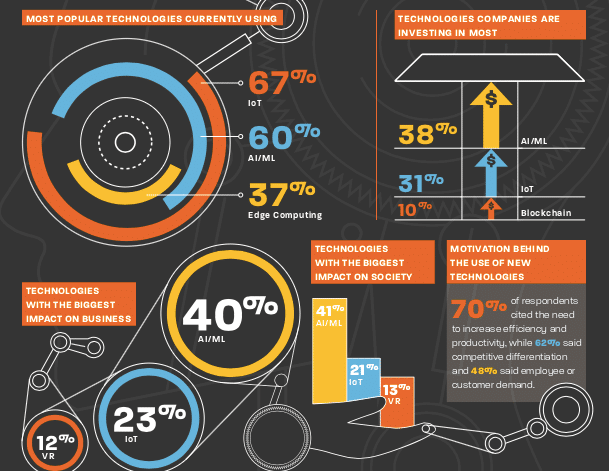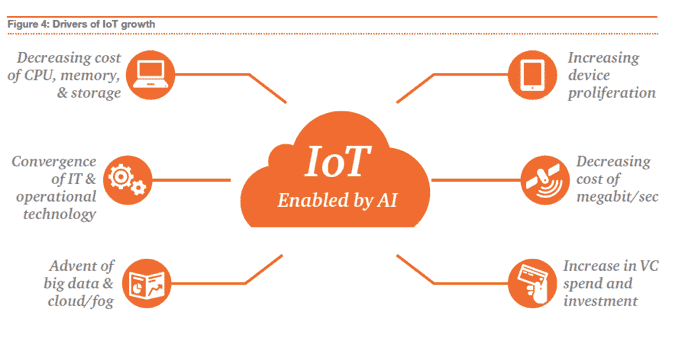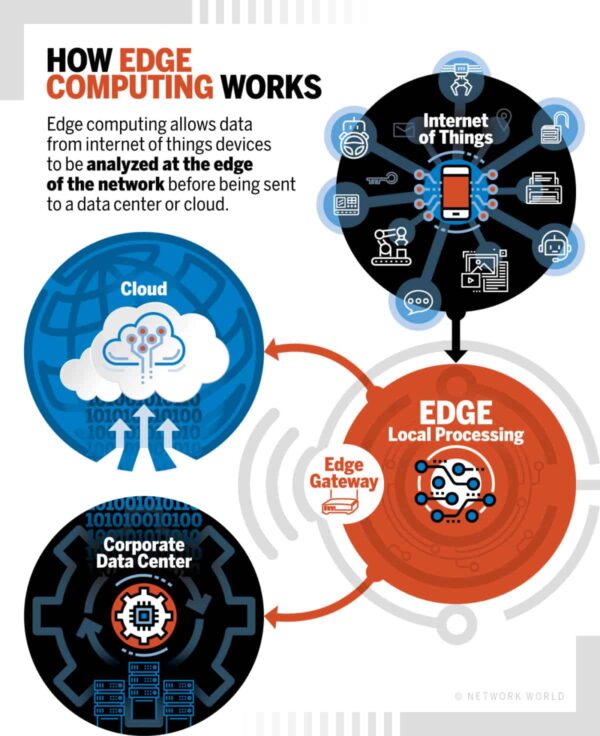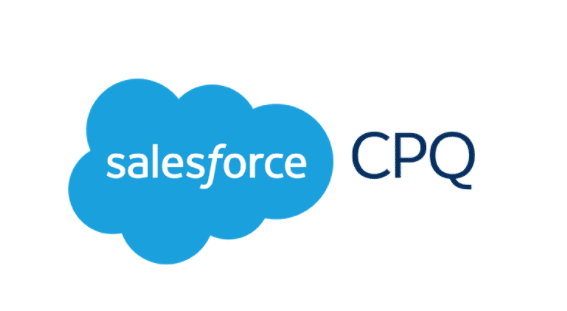How does AI and IoT impact the future of work?
By now you’ve probably figured out that automation in the workplace isn’t going anywhere. The future of work, between advances and inter-connectivity in AI and IoT (Artificial Intelligence and the Internet of Things), indicates that things are speeding up, and the concept of “busy work” is becoming a thing of the past. Businesses have been looking for ways to improve upon processes with the use of new technology since the beginning of business, and there isn’t much in this world that can stop progress. Ultimately, if you’re not willing to compete with those who embrace new technology, you’ll likely find yourself increasingly unable to compete as time marches on and innovation in the workplace gets more technical.

AI
Artificial Intelligence isn’t about robots taking human jobs. The future of work is about changing tedious, time and revenue consuming, manual jobs, into strategically automated tasks and systems.
Professional Services related to the technology industry, supply chain management and operations, strategy, and customer services will become increasingly dependent on AI technologies in order to stay competitive in the marketplace. This goes for media and telephony organizations, consumer retail, financial services, health care, industrial, energy companies, and beyond.
Even though most organizations at this point agree on the fact that AI will enable them to maximize their competitive advantage, less than a quarter of these organizations have successfully implemented such technologies, and those who have, are in the pilot stages, and have not fully adopted such systems into their regular operations.
Adoption strategy is just as crucial to the process as the technology itself, because it requires a full stop change in how certain processes are managed, resetting the entire structure of project management and accountability within the organization.
When you’re dealing with implementing foreign technologies in the workplace, critical to the future of work, it’s crucial to embrace the technical and operational help of a specialist or consultant familiar to the subtleties involved in such a major change. But it’s also crucial that your teams and management are on the same page regarding moving towards the new future of work within your organization.
At it’s core, AI is machine learning, and the intelligent use of that data and information. The future of work is impacted by innovations that can be made from such information. When paired with IoT, “smart machines” simulate intelligent behavior to make informed decisions not impacted by human behavior. Boosted productivity results from the tandem innovation of both AI and IoT. As the technology matures and progresses, accuracy will continue to increase as it becomes more intelligent and robust when processing different variables.
What can AI process that we, as humans, simply can’t do as quickly?
Post-Event processing – identifying patterns in data sets and running predictive analytics
Real-Time processing – responding in real-time to conditions and building up knowledge of decisions about those events
Drivers of IoT Growth

The IDC estimates IoT devices will increase from 11 billion in 2016 to 80 billion in 2025, with a corresponding increase in data generation up to 44 zettabytes in 2020, and up to 180 zettabytes in 2025. This creates the following challenges for business when working to create high-performance, agile solutions:
- How to manage IoT data
- How to analyze IoT data
- How to draw insight from IoT data
- How to ensure fast and accurate analysis
- Balancing needs for centralized and localized intelligence
- Balancing personalization with data privacy and confidentiality pressures
- Maintaining security in the face of increasing threats of cyber attack
IoT
Let’s back up for a moment to address the Internet of Things (IoT), what it is, and it’s nature in regards to the future of work. Any “thing,” or device, that is connected to the Internet, and capable of sending and receiving data, is part of IoT. Anything can become IoT, but what is relevant here, is how IoT can be used to benefit the future of work, and change the way we approach business.
If the tools you use to do business, whether it’s B2B or B2C, are now capable of collecting/sending/receiving relevant data from the Internet with less effort, you’re increasing efficiency. More output (units produced, tasks accomplished) with the same input (time, energy, money, resources), or the same output with less input. Industrial app
How does AI intersect with the Internet of Things?
Predictive analytics – “What will happen?”
Prescriptive analytics – “What should we do?”
Adaptive/continuous analytics – “What are the appropriate actions or decisions? How should the system adapt to the latest changes?
Sensors deliver data, but data can only become valuable if it means something important, and is actionable. IoT and AI go hand in hand for determining how to use data in useful ways. IoT can inform AI, and AI brings context and creativity to create informed action.
The Intelligence Continuum
Assisted Intelligence
- Nature of tasks don’t change
- Tasks are automated
- Humans don’t learn
- Machines learn
- Examples: machinery, processes in factories, boilers, ovens
Augmented Intelligence
- Nature of tasks change
- Humans inform machines
- Machines inform humans
- Examples: business strategy analysis using machine learning, smart clinical decision support
Autonomous Intelligence
- Nature of tasks change
- Decisions are automated
- Machines learn continuously
- Examples: autonomous vehicle, smart investment
With the combination of AI and IoT, technological solutions can create continuous data feeds, where over time, the system learns, and can take the best course of action without human intervention. Smart machines are advancing, and are moving from the technology that built the ability to perform repeatable, automated tasks, to learning to deal with continuously changing tasks.
But before this kind of technology can be implemented on the business scale, organizations have to learn to adapt. This will create new markets, new strategies, and new opportunities that will cause a total disruption in traditional business models, dramatically changing the way businesses compete. The faster organizations that interested in longevity, and willing to adapt, move on adoption, the better their competitive advantage in the future when the use of these technologies becomes more mainstream.
How product and services industries will be impacted by AI and IoT
Manufacturing can utilize connected sensors to monitor and manage the health of manufacturing equipment, which, over time can help identify root causes of defects, and improve production, quality, and the value of depreciating assets over time.
Health care equipment actively monitors data about how well the human body is working, blood sugar, blood pressure, insulin, various scans, therefore there are vast opportunities to improve upon the way we monitor health, catch the signs of disease early on, or help to avoid it altogether.
Financial Services can potentially benefit from ‘things’ regarding their customer’s mobile phones, payment cards…in relation to fraud detection and two-factor authentication, for example.
The big shift in the future of business models
IoT is supporting the changes in society that we’re already beginning to witness. Products are becoming services. Rather than owning a car, many are opting for ride-sharing services. Airlines are finding ways to pay hourly for times when the aircraft’s engine is propelling, rather than paying manufacturers for the maintenance of engines. If your service requires a physical asset, it’s ideal that the physical asset run itself…in which case IoT comes in handy, allowing providers to remotely monitor and collect data – how it’s performing, how it’s being used, and environmental factors, which can all work together to help automate much of the assets management.
But again, what good is the collection of data, without driving context from it, which is why AI is essential.
What is “the edge” about?
Intelligence is moving towards edge devices. It’s a trend towards machine learning that is run on the end device, such as smartphones or automobiles, rather than in the Cloud. Most AI algorithms need huge amounts of computing data and computing power, rallying on powerful servers and central data storage.
To be sure that data is processing at an efficient rate, edge computing becomes necessary. Because of the nature of Big Data, many would assume that data obtained on edge devices should be directed back to the central data processing center or a Cloud repository; however, that isn’t realistic. Instead, with edge computing, IoT devices are transferring data to local devices to store and process, and only a portion of that data is sent to the central data repository, or corporate data center.

This matters in a variety of circumstances:
- When IoT devices have poor connectivity, perhaps due to remote locations, and it’s not efficient for the ‘thing’ to be constantly connected to a central Cloud
- Latency-sensitive data processing, such as financial services or manufacturing processes, where milliseconds of latency is unsustainable.
- The build-out of next-gen 5G cellular networks, which are using micro-data centers either integrated into, or located near 5G towers.
Security and logistics for edge computing depend on a variety of variables, like what kind of data the edge devices are collecting, and how useful would that data be to hacker, without context or meaning.
It’s arguable that security for an organization is improved by implementing edge devices, because the less data being shared over a network, the better. If the main Cloud environment is compromised, data from edge devices (or at least some of it) won’t be stored or processed there, thereby keeping that data away from harm.
However, it can also be argued that the edge computing devices themselves can be breached without access to to the main data processing center, which, depending on the kind of data being collected, is also a great risk.
Security from all access points will continue to be paramount as organizations temper the way they manage their data.
It’s doubtful that the Cloud and/or huge data processing centers will go anywhere, and more likely that the Cloud and the Edge will work symbiotically. While the Edge will allow certain functions that require speed and quick processing to redistribute data processing that is latency-sensitive, data centers and the Cloud will still function for mass storage and data processing.
All of this begs the question: How do modern day workplaces prepare for this kind of technology shift?
- Find the right talent as you research the right technological solutions. AI and Data Scientists will be crucial.
- Make the right data available to all who need it. Your data needs to be clean, and available to data scientists and business analysts who are trained to manipulate and interrogate the data in useful ways.
- Be willing to change your company culture to attract new talent. Competitive pay and benefits is obvious. But are you catering to open, flexible, and cooperative cultures that attract top talent?
- Implement change management initiatives and technical consulting agencies to address job concerns. With huge technological shifts, comes technological positions that require some re-imagining, training and shifts in roles.
While all of this seems ahead of the game for most services organizations, the sooner business leaders begin to prepare for such changes the better.





